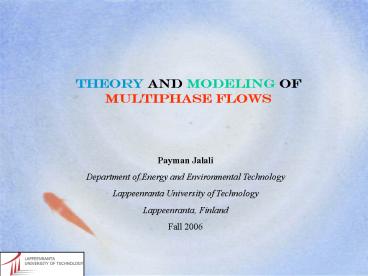Theory and modeling of multiphase flows - PowerPoint PPT Presentation
1 / 24
Title:
Theory and modeling of multiphase flows
Description:
Some industrial fluid flow processes can be mentioned below: ... Diesel engines - Aerated bio-reactors. Introduction to the CFD modeling of multiphase flows ... – PowerPoint PPT presentation
Number of Views:341
Avg rating:3.0/5.0
Title: Theory and modeling of multiphase flows
1
Theory and modeling of multiphase flows
Payman Jalali Department of Energy and
Environmental Technology Lappeenranta University
of Technology Lappeenranta, Finland Fall 2006
2
Introduction to the CFD modeling of multiphase
flows
In the first part of this course, after some
introductory discussion on continuum mechanics
and derivation of governing equations in
single-phase fluid flows, we reviewed the
elementary modeling methods of two-phase flows,
namely homogeneous flow theory and separated
flow theory. In the second part of this course,
we will focus on the methods used in CFD
modeling.
3
Introduction to the CFD modeling of multiphase
flows
Different modeling methods are used for
gas-liquid or gas-solid mixtures as shown in the
table.
4
Introduction to the CFD modeling of multiphase
flows
- Some industrial fluid flow processes can be
mentioned below - Single-phase flows
- - Combustion chambers, furnaces - Flow in
pipelines - - Gas dispersion - Internal combustion engines
- - Gas fires and explosions
- Multi-phase flows
- - Flow in pipelines - Gas/liquid seperators
- - Coal combustors - Fluidized beds
- - Diesel engines - Aerated bio-reactors
5
Introduction to the CFD modeling of multiphase
flows
- The need for flow simulations
- Strong influence of design parameters on the
various processes occuring in industrial
equipment - Computer simulation of the interactions of the
processes in a flowing system will improve - - Basis for new designs
- - Estimation of operational characteristics
- - Better basis of performance of equipment from
various vendors - - Efficiency of various counter-measures in
safety analysis
6
Introduction to the CFD modeling of multiphase
flows
Modeling Zero- versus multi-dimensional CFD
models
- Multi-dimensional CFD models
- Set of partial differential equations
- Momentum equations need to be solved
- Zero-dimensional models
- Set of ordinary differential equations
- No momentum equations need to be solved
7
Introduction to the CFD modeling of multiphase
flows
- Different classes of methods exist in the
modeling of multiphase flows - PSIC (Particle-Source-In-Cell)
- - Continuous phase (liquid or gas) is Eulerian
- - Dispersed phase (bubbles, droplets or
particles) is Lagrangian - Volume Of Fluid (VOF) technique
- - The interface between gas and liquid is
calculated and thus it is able to resolve the
details of the bubble shape as it moves through
the liquid - Multi-fluid method
- - Phases are treated as interpenetrating fluids
that share the space and interact with
each other through the source terms
8
Introduction to the CFD modeling of multiphase
flows
Multi-fluid method Transport equations governing
the conservation of mass, momentum, and
scalar variables like turbulent quantities kl and
?l for gas-liquid flows, enthalpy (hk) and
concentration of chemical species (Yj,k) are
derived for each phase k.
Conservation of mass for phase k
9
Introduction to the CFD modeling of multiphase
flows
Conservation of momentum for phase k
10
Introduction to the CFD modeling of multiphase
flows
Conservation of scalars for phase k
11
Introduction to the CFD modeling of multiphase
flows
Interfacial forces
12
Introduction to the CFD modeling of multiphase
flows
Shape regimes for bubbles and drops
13
Introduction to the CFD modeling of multiphase
flows
Drag force
14
Introduction to the CFD modeling of multiphase
flows
15
Introduction to the CFD modeling of multiphase
flows
16
Introduction to the CFD modeling of multiphase
flows
17
Introduction to the CFD modeling of multiphase
flows
18
Introduction to the CFD modeling of multiphase
flows
19
Introduction to the CFD modeling of multiphase
flows
20
Introduction to the CFD modeling of multiphase
flows
21
Introduction to the CFD modeling of multiphase
flows
22
Introduction to the CFD modeling of multiphase
flows
23
Introduction to the CFD modeling of multiphase
flows
24
Reference
Hjertager B.H., Basic numerical analysis of
multiphase flows, Lecture notes, HUT, ESPOO (2006)































